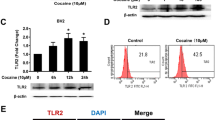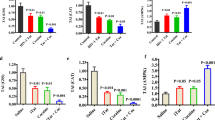Abstract
While it has been well-documented that drugs of abuse such as cocaine can enhance progression of human immunodeficiency virus (HIV)-associated neuropathological disorders, the underlying mechanisms mediating these effects remain poorly understood. The present study was undertaken to examine the effects of cocaine on microglial viability. Herein we demonstrate that exposure of microglial cell line-BV2 or rat primary microglia to exogenous cocaine resulted in decreased cell viability as determined by MTS and TUNEL assays. Microglial toxicity of cocaine was accompanied by an increase in the expression of cleaved caspase-3 as demonstrated by western blot assays. Furthermore, increased microglial toxicity was also associated with a concomitant increase in the production of intracellular reactive oxygen species, an effect that was ameliorated in cells pretreated with NADPH oxidase inhibitor apocynin, thus emphasizing the role of oxidative stress in this process. A novel finding of this study was the involvement of endoplasmic reticulum (ER) signaling mediators such as PERK, Elf2α, and CHOP, which were up regulated in cells exposed to cocaine. Reciprocally, blocking CHOP expression using siRNA ameliorated cocaine-mediated cell death. In conclusion these findings underscore the importance of ER stress in modulating cocaine induced microglial toxicity. Understanding the link between ER stress, oxidative stress and apoptosis could lead to the development of therapeutic strategies targeting cocaine-mediated microglial death/dysfunction.







Similar content being viewed by others
References
Aksenov MY, Aksenova MV, Nath A, Ray PD, Mactutus CF, Booze RM (2006) Cocaine-mediated enhancement of Tat toxicity in rat hippocampal cell cultures: the role of oxidative stress and D1 dopamine receptor. Neurotoxicology 27:217–228
Block ML, Hong JS (2007) Chronic microglial activation and progressive dopaminergic neurotoxicity. Biochem Soc Trans 35:1127–1132
Block ML, Zecca L, Hong JS (2007) Microglia-mediated neurotoxicity: uncovering the molecular mechanisms. Nat Rev Neurosci 8:57–69
Buch S, Yao H, Guo M, Mori T, Su TP, Wang J (2011) Cocaine and HIV-1 interplay: molecular mechanisms of action and addiction. J Neuroimmune Pharmacol 6:503–515
Chakrabarti A, Chen AW, Varner JD (2011) A review of the mammalian unfolded protein response. Biotechnol Bioeng 108:2777–2793
Choe ES, Ahn SM, Yang JH, Go BS, Wang JQ (2011) Linking cocaine to endoplasmic reticulum in striatal neurons: role of glutamate receptors. Basal Ganglia 1:59–63
Colton CA, Wilcock DM (2010) Assessing activation states in microglia. CNS Neurol Disord Drug Targets 9:174–191
Crawford FC, Wood M, Ferguson S, Mathura VS, Faza B, Wilson S, Fan T, O’Steen B, Ait-Ghezala G, Hayes R, Mullan MJ (2007) Genomic analysis of response to traumatic brain injury in a mouse model of Alzheimer’s disease (APPsw). Brain Res 1185:45–58
Crews FT, Vetreno RP (2011) Addiction, adolescence, and innate immune gene induction. Front Psychiatry 2:19
Crews FT, Zou J, Qin L (2011) Induction of innate immune genes in brain create the neurobiology of addiction. Brain Behav Immun 25(Suppl 1):S4–S12
Dabbouseh NM, Ardelt A (2011) Cocaine mediated apoptosis of vascular cells as a mechanism for carotid artery dissection leading to ischemic stroke. Med Hypotheses 77:201–203
Garcia RC, Dati LM, Fukuda S, Torres LH, Moura S, de Carvalho ND, Carrettiero DC, Camarini R, Levada-Pires AC, Yonamine M, Neto ON, Abdalla FM, Sandoval MR, Afeche SC, Marcourakis T (2012) The neurotoxicity of anhydroecgonine methyl ester, a crack cocaine pyrolysis product. Toxicol Sci 128:223–234
Go BS, Ahn SM, Shim I, Choe ES (2010) Activation of c-Jun N-terminal kinase is required for the regulation of endoplasmic reticulum stress response in the rat dorsal striatum following repeated cocaine administration. Neuropharmacology 59:100–106
Gurwell JA, Nath A, Sun Q, Zhang J, Martin KM, Chen Y, Hauser KF (2001) Synergistic neurotoxicity of opioids and human immunodeficiency virus-1 Tat protein in striatal neurons in vitro. Neuroscience 102:555–563
Harding HP, Zhang Y, Ron D (1999) Protein translation and folding are coupled by an endoplasmic-reticulum-resident kinase. Nature 397:271–274
Hayashi T, Su TP (2007) Sigma-1 receptor chaperones at the ER-mitochondrion interface regulate Ca(2+) signaling and cell survival. Cell 131:596–610
Ji KA, Yang MS, Jeong HK, Min KJ, Kang SH, Jou I, Joe EH (2007) Resident microglia die and infiltrated neutrophils and monocytes become major inflammatory cells in lipopolysaccharide-injected brain. Glia 55:1577–1588
Katz JL, Su TP, Hiranita T, Hayashi T, Tanda G, Kopajtic T, Tsai SY (2011) A role for sigma receptors in stimulant self administration and addiction. Pharm (Basel) 4:880–914
Lin JH, Walter P, Yen TS (2008) Endoplasmic reticulum stress in disease pathogenesis. Annu Rev Pathol 3:399–425
Marciniak SJ, Garcia-Bonilla L, Hu J, Harding HP, Ron D (2006) Activation-dependent substrate recruitment by the eukaryotic translation initiation factor 2 kinase PERK. J Cell Biol 172:201–209
Marciniak SJ, Yun CY, Oyadomari S, Novoa I, Zhang Y, Jungreis R, Nagata K, Harding HP, Ron D (2004) CHOP induces death by promoting protein synthesis and oxidation in the stressed endoplasmic reticulum. Genes Dev 18:3066–3077
Matsumoto RR, Liu Y, Lerner M, Howard EW, Brackett DJ (2003) Sigma receptors: potential medications development target for anti-cocaine agents. Eur J Pharmacol 469:1–12
Muzio M, Stockwell BR, Stennicke HR, Salvesen GS, Dixit VM (1998) An induced proximity model for caspase-8 activation. J Biol Chem 273:2926–2930
Orrenius S (2007) Reactive oxygen species in mitochondria-mediated cell death. Drug Metab Rev 39:443–455
Schroder M (2008) Endoplasmic reticulum stress responses. Cell Mol Life Sci 65:862–894
Shi Y, An J, Liang J, Hayes SE, Sandusky GE, Stramm LE, Yang NN (1999) Characterization of a mutant pancreatic eIF-2alpha kinase, PEK, and co-localization with somatostatin in islet delta cells. J Biol Chem 274:5723–5730
Shi Y, Vattem KM, Sood R, An J, Liang J, Stramm L, Wek RC (1998) Identification and characterization of pancreatic eukaryotic initiation factor 2 alpha-subunit kinase, PEK, involved in translational control. Mol Cell Biol 18:7499–7509
Shin EH, Bian S, Shim YB, Rahman MA, Chung KT, Kim JY, Wang JQ, Choe ES (2007) Cocaine increases endoplasmic reticulum stress protein expression in striatal neurons. Neuroscience 145:621–630
Tabas I, Ron D (2011) Integrating the mechanisms of apoptosis induced by endoplasmic reticulum stress. Nat Cell Biol 13:184–190
Turchan J, Anderson C, Hauser KF, Sun Q, Zhang J, Liu Y, Wise PM, Kruman I, Maragos W, Mattson MP, Booze R, Nath A (2001) Estrogen protects against the synergistic toxicity by HIV proteins, methamphetamine and cocaine. BMC Neurosci 2:3
Walter P, Ron D (2011) The unfolded protein response: from stress pathway to homeostatic regulation. Science 334:1081–1086
Xu C, Bailly-Maitre B, Reed JC (2005) Endoplasmic reticulum stress: cell life and death decisions. J Clin Invest 115:2656–2664
Yang MS, Ji KA, Jeon SB, Jin BK, Kim SU, Jou I, Joe E (2006) Interleukin-13 enhances cyclooxygenase-2 expression in activated rat brain microglia: implications for death of activated microglia. J Immunol 177:1323–1329
Yang MS, Park EJ, Sohn S, Kwon HJ, Shin WH, Pyo HK, Jin B, Choi KS, Jou I, Joe EH (2002) Interleukin-13 and −4 induce death of activated microglia. Glia 38:273–280
Yao H, Bethel-Brown C, Buch S (2009) Cocaine exposure results in formation of dendritic varicosity in Rat primary hippocampal neurons. Am J Infect Dis 5:26–30
Yao H, Kim K, Duan M, Hayashi T, Guo M, Morgello S, Prat A, Wang J, Su TP, Buch S (2011) Cocaine hijacks sigma1 receptor to initiate induction of activated leukocyte cell adhesion molecule: implication for increased monocyte adhesion and migration in the CNS. J Neurosci 31:5942–5955
Yao H, Yang Y, Kim KJ, Bethel-Brown C, Gong N, Funa K, Gendelman HE, Su TP, Wang JQ, Buch S (2010) Molecular mechanisms involving sigma receptor-mediated induction of MCP-1: implication for increased monocyte transmigration. Blood 115:4951–4962
Acknowledgment
Funding
This work was supported by grants DA020392, DA023397 and DA024442 (SB) and DA030285 (HY) from the National Institutes of Health.
Conflict of interest statement
Authors claim no actual or potential conflicts of interest
Author information
Authors and Affiliations
Corresponding author
Electronic supplementary material
Below is the link to the electronic supplementary material.
ESM 1
(DOCX 1214 kb)
Rights and permissions
About this article
Cite this article
Costa, B.M., Yao, H., Yang, L. et al. Role of Endoplasmic Reticulum (ER) Stress in Cocaine-Induced Microglial Cell Death. J Neuroimmune Pharmacol 8, 705–714 (2013). https://doi.org/10.1007/s11481-013-9438-8
Received:
Accepted:
Published:
Issue Date:
DOI: https://doi.org/10.1007/s11481-013-9438-8




